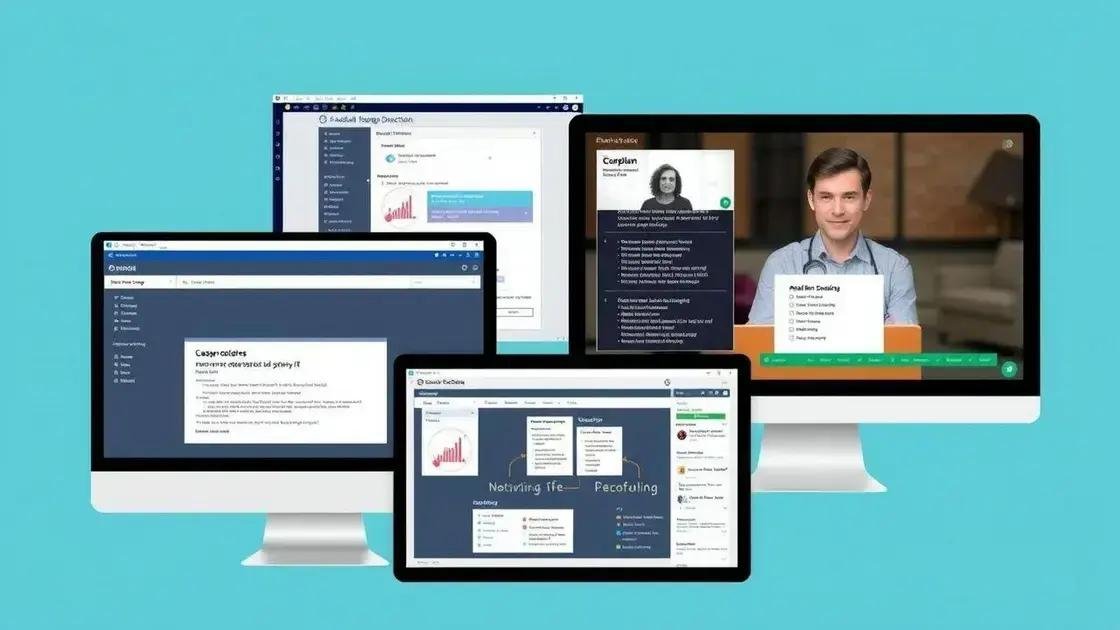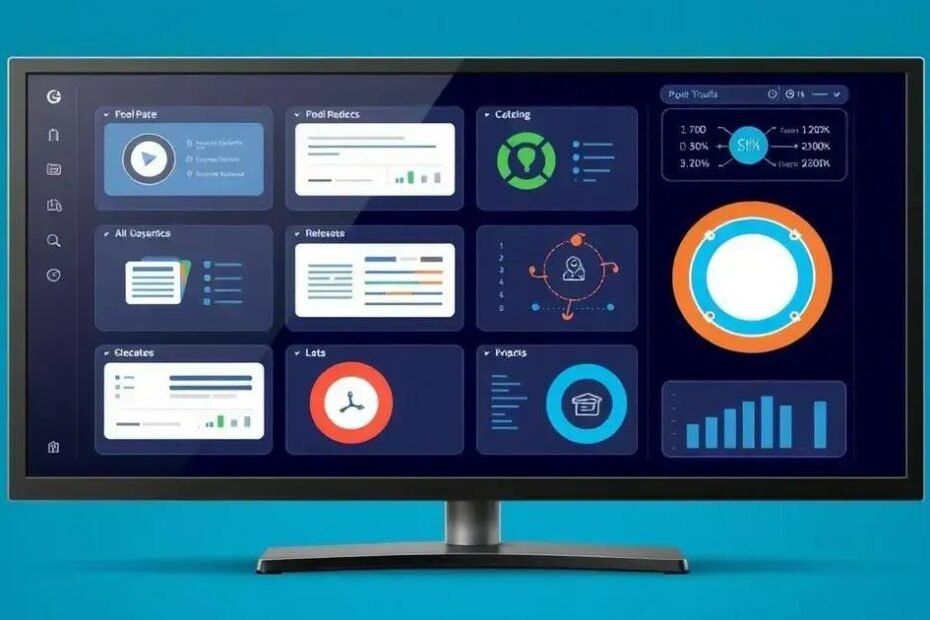Detection tools for academic integrity are essential in preventing plagiarism and cheating, ensuring originality, accountability, and maintaining a trustworthy educational environment.
Detection tools for academic integrity in AI are becoming essential in today’s educational landscape. As learning shifts towards digital platforms, ensuring integrity is crucial. Ever wondered how these tools precisely work to maintain trust?
Understanding academic integrity
Understanding academic integrity is crucial in a world where information is easily accessible. It refers to the ethical code that students and educators must follow to ensure honest communication and fair assessment. This concept helps maintain a level playing field in academic settings and ensures that every individual’s work is protected.
What is Academic Integrity?
Academic integrity encompasses a variety of principles that promote honesty and responsibility. It includes the commitment to avoid plagiarism, cheating, and any form of misrepresentation of one’s work. Upholding these values fosters trust between students and educators.
- Honesty in submissions and assessments
- Respect for others’ work
- Responsibility in research and citations
- Fairness in evaluation and grading
In addition to the basic definitions, academic integrity also involves an understanding of the implications of not adhering to these principles. Students who engage in dishonest practices may face serious consequences, including disciplinary actions. Additionally, relying on AI detection tools can assist in identifying breaches of integrity.
The Role of Students and Educators
Both students and educators play vital roles in maintaining academic integrity. Educators set the standards and provide guidance, while students must take responsibility for their actions. Open communication between both parties is essential for developing a culture of integrity.
Creating assignments that encourage original thought and understanding is one way educators can promote integrity. On the flip side, students can enhance their understanding of what constitutes plagiarism and other violations. Knowing the rules helps prevent unintentional breaches.
Furthermore, resources like workshops and seminars on academic ethics can further enrich understanding. Such initiatives equip students with the necessary tools to navigate their academic journey responsibly.
The role of AI in education
The role of AI in education is rapidly evolving, transforming classrooms and learning experiences. From personalized learning to efficient administrative tasks, AI technology offers various benefits to both teachers and students.
Personalized Learning
One of the most significant impacts of AI is its ability to provide personalized learning experiences. AI systems can analyze a student’s performance and adapt learning materials to meet individual needs. This customization allows students to learn at their own pace, making education more effective.
- Identifying strengths and weaknesses
- Adapting content to suit learning styles
- Providing instant feedback on performance
- Enhancing engagement through tailored resources
As a result, students become more motivated and confident in their abilities. Moreover, AI-driven platforms help teachers create more diverse learning environments, ensuring every student receives the support they need to succeed.
Administrative Efficiency
AI also streamlines administrative tasks, allowing educators to focus on teaching. Tasks such as grading, attendance tracking, and scheduling can be automated with AI tools. This efficiency saves time and reduces stress for teachers, enabling them to dedicate more energy to their students.
Integrating AI into administrative functions enhances communication between students and educators as well. For instance, AI chatbots can address common queries, helping students access information quickly. This interaction fosters a more responsive educational environment.
Furthermore, traditional methods of data management are transformed through AI. Educators can now track student progress more accurately and make data-driven decisions that lead to improved academic outcomes.
Types of detection tools available

There are several types of detection tools available that help uphold academic integrity. These tools leverage technology to identify plagiarism, cheating, and other forms of academic misconduct. Understanding these tools is crucial for both educators and students.
Plagiarism Detection Software
The most common among detection tools is plagiarism detection software. These tools scan submitted work against a vast database of online content, scholarly articles, and previously submitted papers. By doing so, they help identify any instances of copied text.
- Turnitin
- Grammarly
- Copyscape
- Unicheck
Each of these platforms has unique features, yet they all serve the same purpose of maintaining integrity in academic writing. Educators can use these tools to ensure that students submit original work, while students can use them to check their own submissions before turning them in.
Online Exam Proctoring Tools
Another significant type of detection tool is online exam proctoring tools. These tools are designed to monitor students during online assessments, ensuring that they do not cheat. Proctoring can involve video monitoring, screen sharing, and even AI analysis.
- ProctorU
- Respondus
- ExamSoft
- Honorlock
Proctoring tools help create a fair environment for all students, making it difficult to engage in dishonest behavior during exams. This is especially important as online education continues to grow.
In addition, many institutions are adopting a combination of these tools to create a comprehensive strategy for academic integrity. For example, a school might use plagiarism detection software alongside exam proctoring services to cover all bases. This integration helps foster an academic culture built on trust and respect.
Benefits of using detection tools
The benefits of using detection tools in academic settings are profound and far-reaching. These tools not only help maintain academic integrity but also support a positive learning environment.
Enhancing Originality
One key benefit is that detection tools encourage originality among students. When students know that their work will be assessed by sophisticated software, they are more likely to create unique content rather than relying on copying others. This practice fosters creativity and critical thinking, essential skills for any academic path.
- Promotes unique expression of ideas
- Encourages independent research and learning
- Builds confidence in writing
- Reduces anxiety about plagiarism
Consequently, students are motivated to engage more deeply with their subjects. Original work is not only rewarding but vital for personal and academic growth.
Improving Accountability
Detection tools also improve accountability in the educational process. They hold both students and educators responsible for maintaining high standards of integrity. When students understand that their actions have consequences, they are more likely to adhere to ethical practices.
For example, educators can employ these tools to establish a culture of trust. When students see that their teachers value integrity, they are more inclined to uphold it themselves, creating a healthier, more respectful learning environment.
Moreover, these tools can help institutions maintain their reputation by minimizing academic dishonesty cases. Ensuring that students engage in honest practices encourages a strong sense of community and shared values.
Challenges in implementing detection tools
Implementing detection tools in educational systems presents several challenges. While these tools are beneficial, schools and universities must navigate various obstacles to use them effectively.
Resistance to Change
One major challenge is the resistance to change among educators and staff. Many educators may feel comfortable with traditional methods of assessment. Integrating new technology can be intimidating, leading to reluctance to adopt these tools.
- Fear of technology misuse
- Unfamiliarity with new systems
- Concerns about effectiveness
- Perceived complexity of implementation
Professional development and training sessions can help ease some of these concerns, educating teachers on the advantages and functionalities of detection tools.
Technical Issues
Another challenge is technical issues related to integrating detection tools into existing systems. Compatibility between tools and current learning management systems can sometimes be problematic, leading to inefficiencies. Schools may face:
- Software compatibility problems
- Cost of implementation and maintenance
- Internet connectivity issues
- Training and support requirements
These technical challenges can deter administrators from investing in detection tools, despite their potential benefits. Overcoming these hurdles requires careful planning and resource allocation.
Furthermore, privacy concerns are crucial when implementing detection tools. Educational institutions must ensure that students’ data is secure and that their privacy is respected. Establishing trust between students and the institution is essential for effective tool adoption.
FAQ – Questions about detection tools for academic integrity
What are detection tools for academic integrity?
Detection tools are software or systems designed to identify instances of plagiarism, cheating, and other forms of academic misconduct.
How do plagiarism detection tools work?
These tools scan submitted documents against databases of existing content to find similarities, helping to ensure originality in academic work.
What challenges are faced when implementing these tools?
Challenges include resistance to change, technical issues, privacy concerns, and costs associated with implementation.
Why are detection tools important in education?
They promote a culture of honesty, improve accountability, and enhance the overall learning environment by ensuring that students submit their own work.

